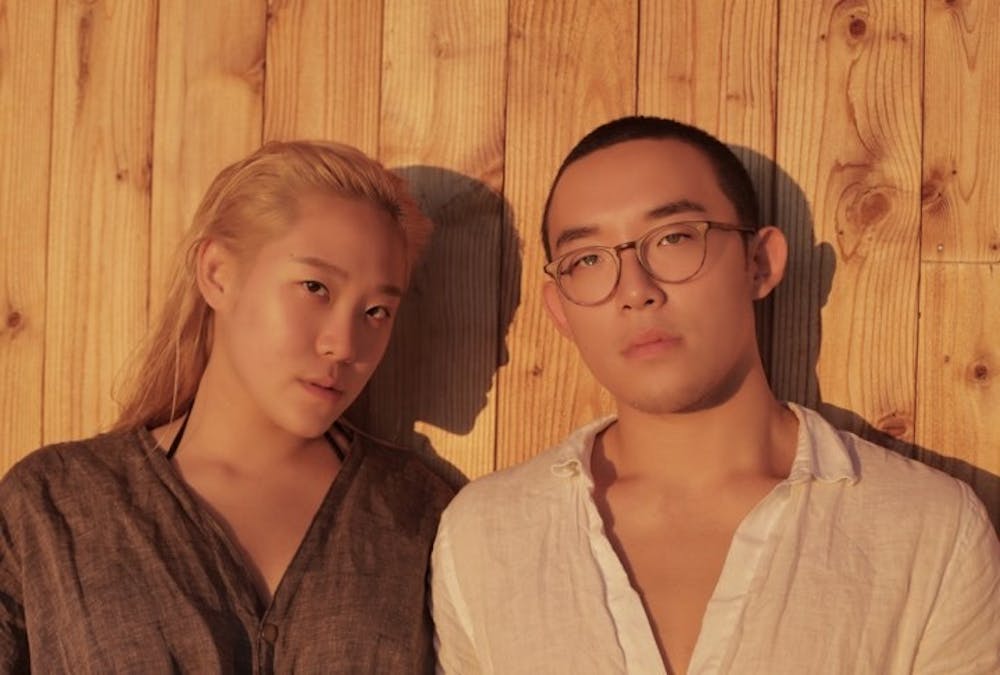A loop for a spliff tucked on the side of a baseball cap. Punny patches with nugs and joints hidden in traditional Korean symbols. Velvet tuxedo stripe trousers with pockets as deep as the fabric is plush so you can sesh in style.
These are all elements of what the two masterminds behind the Seoul–NYC based streetwear brand Sundae School coined as “smokewear.”
Cindy Lim (W’18), Sundae School's CEO and the younger half of the sibling duo in charge of the company, explained that the idea to create apparel for stoners came out of a love of smoking with her brother—an activity that brought the two closer together as they got older. From that love of sparking up, along with help from their “tiger mom," who instilled in the siblings the importance of higher thought and education (Dae, Cindy’s brother, graduated from Harvard in 2014) and their long–time love of fashion, a vision to create a new class of stoner–wear was born.
Cindy insists that all of their successes and accomplishments are organic—they haven’t spent a cent on marketing or promoting the brand, and every contact they’ve made in the fashion world has come from walking the streets of Seoul’s garment district, cold–calling heads of industry, or DM—ing trendsetters on Instagram. That’s how Cindy got the brand featured in Vogue and got Snoop Dogg’s son, Cordell Broadus, to rep their clothes.
“For Dae and me, smoking—we consider it our sport. There’s skatewear for people who skate, and surfwear for people who surf. For smoking people, there should be smokewear.”

Lim riffed on the lack of chic yet comfortable clothes available for those who have a “love of the nug”—not only in the fashion industry, but in pop culture in general. “We really focus on functionality, so our clothes are really comfortable. But at the same time there’s a lot of like rasta weed wear, like Wiz Khalifa ‘let’s get high and whatever, fuck everyone.’ Ours is more like an intellectual high,” she said. “Our first collection was all puns and had intellectual elements to it. So you can look great, you can look chic and great, but the clothes will be super comfy all the time.”
Lim’s effortless personal style and nonchalance are hallmarks of the brand—although she insists that the creative side of the company, including envisioning and creating the clothes, is completely managed by her older brother. But it’s the siblings’ highbrow, subtle, yet sharp–witted humor that makes Sundae School more than just another streetwear brand trying to carve out its space. “We are a streetwear brand just because we try to capture street looks, especially street looks of Seoul. Our second collection has a lot of looks of Korea, but we’re different in that we don’t follow a trend,” Lim said. “We try to put the ‘high’ element, as in higher education, higher thinking and being high—pun intended—in our streetwear. So we’re high streetwear.”
The Lim siblings just soft–launched Sundae School’s second collection, Chapter 2: When Tigers Used To Smoke, this past Sunday (get it?). The phrase comes from traditional Korean folklore, where it is used to begin stories like the familiar European phrase "once upon a time,” and is used colloquially now to mean “way back when.” In a departure from Sundae School’s first collection, Chapter 1: Genesis, which dropped last 4/20 and played off the biblical theme of “creation if God was high,” Chapter 2 instead looks back on Korean history. While the Chapter 1 collection was made up of what you would typically see on the streets of Korean cities and would generally expect out of a streetwear brand (hoodies, baseball hats, long–sleeves, etc.), the Chapter 2 collection reinterprets traditional Korean garb called hanbok and uses unexpected fabrics to give a modern update to typical dress.

The evolution of Sundae School’s clothes elevates the brand from streetwear startup to fashion activism. While both collections are homages to the siblings’ hometown of Seoul—with Genesis focusing on the hidden stoner culture and streetwear fascination and When Tigers Used To Smoke inspired more by classical dress—Sundae School’s latest drop has a clear declaration of the siblings’ pride as Asian–American designers and individuals. It is this unapologetic ferocity of not losing their roots to trendiness that has propelled Dae and Cindy to success. Their designs have graced not only the sites of HypeBeast, Paper Magazine, High Snobiety, and Vogue, but the catwalks of New York Fashion Week: Men’s this past summer—all within a year of dropping their first collection.
“A lot of people think that the fashion industry is all glamorous. But it’s really laborious,” she said. “And if it’s meant to happen, it happens.”







